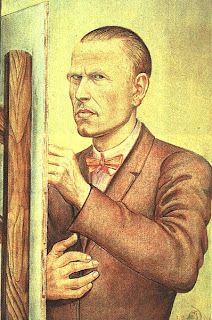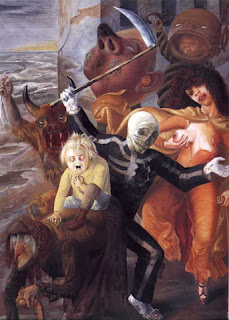Self-Portrait with Easel, 1926. Leopold-Hoesch-Museum, Düren.
One of my favorite artists, Otto Dix . He's usually categorized with German Expressionists, but there are many facets to his oeuvre. Surprisingly, he's still not widely known, nor is Neue Sachlichkeit, and perhaps he's less popular than Max Beckmann or George Grosz.
Dix was also targeted by the Nazis and in the exhibition 'Entartete Kunst.' Above exhibition photo shows War Cripples (1920), confiscated and later destroyed.
The Match Seller, 1920. Staatsgalerie Stuttgart.
Prague Street, 1920. Galerie der Stadt, Stuttgart.
Skat Players, 1920. Staatliche Museen zu Berlin, Neue Nationalgalerie.
The Salon, 1921. Kunstmuseum Stuttgart.
Melancholie, 1930. Kunstmuseum Stuttgart.
Vanitas (Youth and Old Age), 1932. Zeppelin Museum Friedrichshafen.
The Seven Deadly Sins, 1933. Staatliche Kunsthalle Karlsruhe.
Portrait of the Lawyer Dr. Hugo Simons, 1925. Musée des beaux-arts de Montreal.
Portrait of the Journalist Sylvia von Harden, 1926. Musée National d'Art Moderne, Centre Pompidou, Paris.
Dix excelled in portraiture, at once off-putting and compelling.
In 2006-2007, many of Dix's works were in the exhibition 'Glitter and Doom: German Portraits from the 1920s' at The Met.
There is an exhibition catalogue by the same name (Metropolitan Museum of Art, 2006).
Last year, Neue Galerie in NYC had the first solo museum exhibition in North America of Dix's works.
I suggest getting the exhibition catalogue - Olaf Peters ed./Otto Dix (Prestel, 2010), available thru Neue Galerie's book store or elsewhere.
Also available, Philipp Gutbrod/Otto Dix: The Art of Life (Hatje Cantz, 2010).
If possible, try to get this nice book, Eva Karcher/Dix (TASCHEN, 2002).
Fritz Löffler/Otto Dix: Life and Work (Holmes and Meyer, 1982) is an earlier monograph but one of the best, a very nice book. There's also Fritz Löffler/Otto Dix und der Krieg (Reclam, 1986) which is out of print.
There are other ok books on Otto Dix if ya wanna be completist.
War: Wounded Soldier (Autumn 1916, Bapaume), etching/aquatint/drypoint, 1924.
I've wondered if the cover for particularly issue #2 of Frank Miller's redefining classic Batman: The Dark Knight Returns was inspired by Otto Dix. Above link to see more of Dix's Der Krieg series.
The Shootings of May Third 1808, 1814. Museo del Prado, Madrid.
Street Fight, 1927. Destroyed.
Francisco José de Goya y Lucientes' Los Desastres de la Guerra was not the only inspiration for Dix.
Isenheim Alterpiece, 1512-1516. Musée d'Unterlinden, Colmar/Unterlinden Museum, Colmar.
Cartoon for Metropolis, 1928. Kunstmuseum Stuttgart.
Metropolis, 1928. Galerie der Stadt, Stuttgart.
War Triptyph, 1929-1932. Staatliche Kunstsammlungen, Galerie Neue Meister, Dresden.
In my opinion, Otto Dix is the most worthy heir of not only Goya but of Matthias Grünewald, modern or otherwise, and not only due to his triptychs. This isn't really the most original statement - see above link, not to mention Gardner's Art Through the Ages: The Western Perspective.
I would also recommend grabbing any book on Grünewald. Matthias Grünewald: The Drawings (Hatje Cantz, 2008) especially is on my wish list. It includes writing by the great art historian of the Northern Renaissance Max Friedländer (1867-1958).
Soon, I going to read W.G. Sebald's After Nature (Random House, 2002), part of it about Grünewald.
And above, a pretty good informative blog on things Weimar.




















































